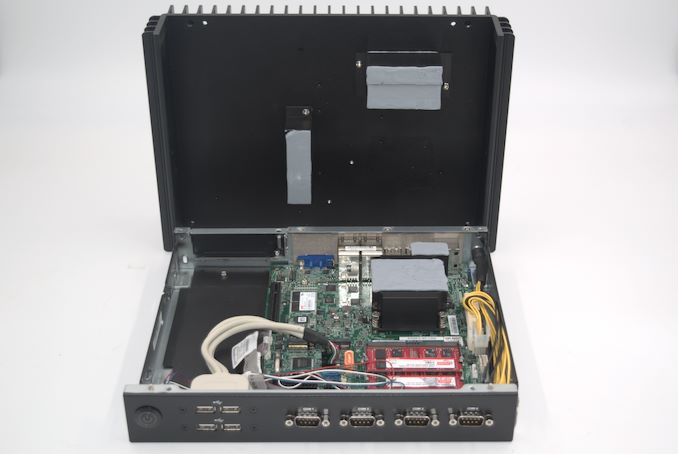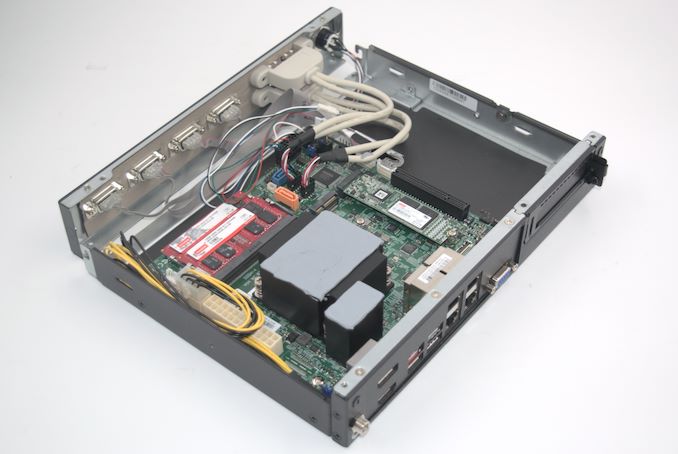Supermicro SYS-E302-12E Fanless Industrial PC Review: Elkhart Lake for IoT Applications
by Ganesh T S on March 10, 2023 8:00 AM EST- Posted in
- Systems
- Fanless
- Supermicro
- Passive Cooling
- Elkhart Lake
Concluding Remarks
Networking and storage are aspects that may be of vital importance in specific industrial use-cases. An IoT server might be required to collect data from a large number of sensor nodes that can communicate via different types of interfaces. The SYS-E302-12E has four RJ-45 network ports, four COM ports, and a large number of USB ports for this purpose. The server must also be able to reliably handle recording of the incoming data (while also being responsive to queries). Fast storage is a must, and the system does support a M.2 NVMe SSDs (operating at PCIe 3.0 x2). Two SATA ports also available to spread out the workload, if desired. Our review configuration included a single M.2 SATA SSD and we have already seen its performance in our review of the SYS-E100-12T-H. The performance in the SYS-E302-12E is bound to be the same or worse, as the CPU horsepower available is obviously much lower.
The Supermicro SYS-E302-12E provided us with the opportunity to evaluate a fanless Elkhart Lake platform with a focus on industrial IoT applications. Based on our evaluation, it is clear that Supermicro has delivered an effective IoT server platform that can operate over a wide temperature range without throttling. The thermal solution is massively over-engineered and capable of handling TDPs as high as 60W. The Atom x6425E's 12W is pretty much an affront to the construction, and the case temperature doesn't cross 40C even under extreme loading conditions. Despite the low processor TDP, the performance for traditional embedded applications is more than satisfactory. The platform is also customizable, with a number of expansion slots available internally for adding wireless functionality and the like.
There are two minor concerns that prospective customers need to keep in mind - in-band ECC will be made available only in a future BIOS release, and the platform doesn't have true out-of-band management capabilities (no BMC or vPro / AMT). Idle power consumption numbers are also a bit higher than what would be preferable - it is likely that tweaking some BIOS options could yield some optimization on that front. Some practices like disabling of the TPM by default are not conducive for the out-of-the-box experience with Windows, but most users of the system are likely to adopt a different OS.
The pricing of the barebones system around $900 is on expected lines far a fanless industrial PCs with long life cycle commitments. The system is built for operating under challenging conditions, and offers best-in-class performance and connectivity for its size and price.












16 Comments
View All Comments
t88csywi - Friday, March 10, 2023 - link
Does Intel support WSLg on these Elkhart Lake chips? Their graphics drivers have been broken for months, preventing Jasper Lake systems from running it.https://github.com/microsoft/wslg/issues/877
The_Assimilator - Friday, March 10, 2023 - link
A 150W power brick for a 12W CPU? What???danbob999 - Friday, March 10, 2023 - link
Sounds about right. People buy 500-700W PSUs for 65W CPUs, so...PeachNCream - Friday, March 10, 2023 - link
You're going to upset the people that are drooling over 1kw PSU reviews by pointing that sort of thing out to them and they'll come out of the proverbial woodwork to make claims about peak power draw, worst case scenarios, blah blah burst speeds, overclocking, and every other excuse they can make to avoid admitting they bought into the hype.mode_13h - Saturday, March 11, 2023 - link
> Sounds about right.Not for an industrial product. Also, power supplies tend to be much less efficient at such low utilization. A smaller power brick should reduce both costs and power usage.
mode_13h - Saturday, March 11, 2023 - link
Thinking about it, I can see Ganesh's point. It probably should default to a PSU capable of supporting the max power draw, and then perhaps customers requiring less could spec a leaner model or just do it aftermarket.vidal6x6 - Monday, March 13, 2023 - link
1120w for 200w system ;)Monicalia - Monday, March 27, 2023 - link
Memory has always worked this way from one generation to the next. Not in a straight line. Put aside whatever wrong ideas you may have about timing and know https://sonicexe.io that these times are excellent for 65W.mode_13h - Tuesday, March 28, 2023 - link
Spammer.ganeshts - Friday, March 10, 2023 - link
Not entirely unreasonable given the internal platform. Note that the internal board has a PCIe 3.0 x8 slot, there are two SATA ports, and two M.2 ports. Taking the 8 USB ports into consideration, I can think of the following max usage:8x USB = 40 W
2x M.2 = 20 W
2x SATA = 15 W
1x PCIe = 75 W
SoC = 12 W
DRAM = ~3-5 W
Already over the 150 W mark.. in fact, I think Supermicro also offers a 180 W power brick option for this system.